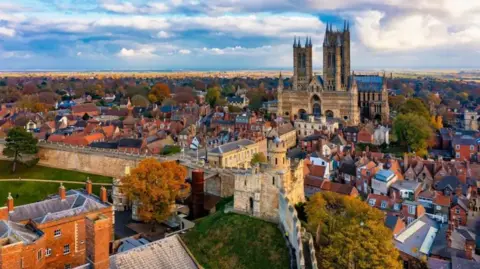Eight options submitted for councils shake-up
 Getty Images
Getty ImagesEight different proposals have been submitted outlining how Greater Lincolnshire should be divided, in what has been described as the most significant shake-up to local government in half a century.
The government recently invited councils to submit interim proposals for reorganisation by Friday 21 March as part of the devolution plan for the area.
The reorganisation aims to merge councils into bigger unitary authorities, expected to be established in 2028, with projected savings of £2bn nationwide.
Feedback is expected by 28 April with final proposals due by 28 November.
The reorganisation was first outlined in Deputy Prime Minister Angela Rayner's devolution white paper in December.
The government has set criteria for proposals, including ensuring each unitary authority covers a population of about 500,000 or more, minimising disruption to services and preferably not crossing county boundaries.
Nearly all councils in Greater Lincolnshire have submitted interim proposals, except for North East Lincolnshire Council, which failed to reach a settled position, and Boston Borough Council.
However, Boston Borough Council leader Anne Dorrian did write to the minister to formally acknowledge the local government reorganisation (LGR) process, according to the Local Democracy Reporting Service.
The eight options
Here is a breakdown of the different options submitted to the government.
- Option 1: North Lincolnshire and North East Lincolnshire councils would merge and Lincolnshire County Council would be combined with all seven district councils.
- Option 2: North Lincolnshire and North East Lincolnshire councils would merge with East Lindsey and West Lindsey. The other new council would combine the county council with the remaining five districts.
- Option 3: South Kesteven and North Kesteven district councils would merge with South Holland and Rutland. Another unitary authority would combine West Lindsey, East Lindsey, Lincoln, and Boston, while a third would merge North Lincolnshire and North East Lincolnshire councils.
- Option 4: The City of Lincoln Council has put forward a three-unitary model for Greater Lincolnshire, which includes expanding the city's boundaries into parts of North Kesteven and West Lindsey.
- Option 5: A proposed Northern Lincolnshire Unitary Council would include North Lincolnshire, North East Lincolnshire, West Lindsey, and the City of Lincoln. The Southern Lincolnshire Unitary Council would include North Kesteven, South Kesteven, Boston, East Lindsey, and South Holland.
- Option 6: Central Lincolnshire would cover West Lindsey, Lincoln, and North Kesteven. A proposed Southern & Coastal Lincolnshire authority would take in East Lindsey, Boston, South Holland, and South Kesteven, while Northern Lincolnshire would cover North Lincolnshire and North East Lincolnshire.
- Option 7: Another three-unitary model would see North Lincolnshire and North East Lincolnshire combining, West Lindsey merging with Lincoln, East Lindsey, and North Kesteven, while South Kesteven, South Holland, and Boston would also merge.
- Option 8: North Lincolnshire and North East Lincolnshire would combine, West Lindsey, Lincoln, North Kesteven, and South Kesteven would merge, and East Lindsey, Boston, and South Holland would also amalgamate.
Listen to highlights from Lincolnshire on BBC Sounds, watch the latest episode of Look North or tell us about a story you think we should be covering here.
